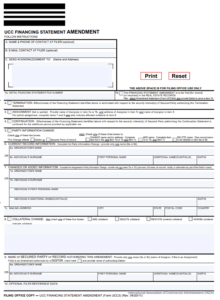5 Types of UCC3 Change Statements
UCC A UCC3 is a change statement to a UCC1.
A UCC3 is a change statement to a UCC1.
It’s an amendment filing to an original UCC1 financing statement that changes or adds information to the originally filed UCC1. It’s a filing tool secured parties use to manage their UCC portfolio to maintain their perfected security interests.
Importantly,
• the timing of UCC3 recording execution
• the accuracy of the data changes or additions
• and choosing the correct amendment type
can all be critical to maintaining a perfected security interest and the original UCC1 priority position.
Before discussing what a UCC3 is, its various types and how they are utilized, a quick review of UCC1s is in order. UCC1 financing statements are recorded filings which give notice to other creditors of a security interest in specific collateral used to secure debt. They are typically recorded to perfect the security interests of a secured party to prioritize their claim position in the event of a debtor default. UCC1s are subject to the effects of subsequently filed documents, whether those documents attach to the original filing, like a UCC3, or not, like a Federal tax lien.
Some of these subsequently filed documents can prime a perfected security interest, like Federal tax liens.
Others, like UCC3s if not executed according to statute, can cause a secured party to lose effectiveness of their lien, their UCC1, and all claims on any collateral should there be a default.
It’s that last piece that is vitally important about UCC3s: they can affect previously perfected security interests depending on when and where they are recorded, what they do, and how accurate the new data is.
What are the Different Types of UCC3s?
There are five different types of UCC3s.
- Continuations – extends the financing statement effectiveness for another five years;
- Party Amendments – adds or amends debtor or secured party information, such as changes to the legal name or the address
- Collateral Amendments – adds or removes collateral from the collateral description, or restates the collateral description completely
- Assignments – transfers “full” or “partial” rights in the filing from one secured party to another
- Terminations – extinguishes a financing statement prior to its five-year lapse date
Where and how are UCC3s recorded?
UCC3s are recorded in the same jurisdiction as the effective UCC1 it amends. A step by step process on how to execute a UCC3 filing can be found here.
What are some examples of the critical nature of each UCC3 type?
- Continuations – there is a 6 month window prior to the UCC1 5-year lapse date in which a Continuation must be recorded for it to be effective; Continuations are not effective if recorded after the lapse date and the UCC1 lapses and becomes ineffective
- Party Amendments – these amendments often coincide with name changes and/or address changes to business entity documents of the parties involved; these name changes and address changes typically require amendments to the original UCC1 identifying these changes within a specific time frame; address changes that involve a change of state have specific UCC3 filing protocols for secured parties to follow within specific time frames
- Collateral Amendments – partial releases are executed as a DELETE collateral descriptions, a critical aspect of this type of UCC3; a collateral restatement is a replacement of a prior collateral description, not an addition to that prior description, so a secured party’s security interest in any collateral that is not fully restated in the UCC3 collateral amendment risks becoming unperfected
- Assignments – sometimes a new UCC1 is required instead of an assignment, depending, and failure to recognize what is required in a situation can result in a secured party’s lien becoming ineffective
- Terminations – other parties can terminate a UCC1 besides the secured party; also, RA9 requires no signatures to record terminations; a termination can be recorded by the debtor under certain circumstances; monitoring services are available which alert secured parties to when another party files a termination on one of their UCCs; contact the secured party to verify the effectiveness of a recorded termination.
Once a UCC1 is recorded and a security interest is perfected, a secured party’s focus shifts to maintaining that perfected security interest and managing the UCC1 going forward until it either lapses or is terminated.
UCC3s are a tool which secured parties use to manage that process.

8 thoughts on “5 Types of UCC3 Change Statements”